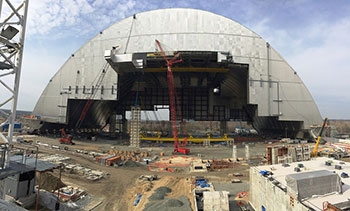
All photos courtesy of European Bank for Reconstruction & Development
Coming in Summer Bulletin: Chernobyl’s Colossal Guardian
30 Years after the Historic Nuclear Meltdown, Clean Up is a Becoming Reality
Thirty years after the April 26, 1986, nuclear disaster at Chernobyl, Ukraine’s notorious Unit 4 reactor, work is wrapping up on a massive steal dome that will enclose the contaminated reactor and allow a safe workspace for the long-term task of dismantling the nuclear waste that remains onsite.
Called the New Safe Confinement (NSC), the structure is an engineering fascination that necessitated over 300 sub projects and $1.7 billion to complete.
In this cover story, the BULLETIN takes a closer look at the engineering behind the NSC and some key structural and environmental elements that make it a one-of-a-kind project and an innovative approach to nuclear containment and safety.
The article features interviews with the NSC project director who is onsite at Chernobyl, and the Chernobyl Shelter Implementation Plan (SIP) managing director from Bechtel Corporation. In addition, the BULLETIN interviewed the director of the Nuclear Safety Department at the European Bank for Reconstruction and Development – the international financial institution managing the SIP – to learn more about the cost of nuclear decommissioning and cleanup projects in Europe.
Following is an excerpt from the story.
Epic Endeavor
Every aspect of the New Safe Confinement project has been epic in proportions. Before work on the NSC even began, the project had to overcome the unmatched challenge of being located at the most radioactive site in the world. Extensive planning involving research, engineering concepts, site infrastructure, and worker protection, was critical.
Vital safety practices had to be incorporated, including an advanced biomedical protection and screening protocol for workers, and enforcing strict radiation dose limits. The construction site itself was built to protect workers from possible exposure to ground radiation.
The visionary project began with site preparation, cleaning and clearing the 970,000-square-foot erection area; then pouring the concrete slabs, which formed the work surface and provide protection from ground radiation. Next was the extensive civil engineering work of laying the blinding concrete and deep foundation and piling work in the trenches. The arch construction involved lifting operations that used towers designed to lift loads over 1,000 metric tons.
“The project is very complex from an engineering point of view. From a managing point of view, the fact that the staff comes from 23 different countries does not simplify the task, but it gives you the opportunity to learn from everyone. Everybody working on the project is proud to do something that is good for the environment,” said Nicolas Caille, Novarka project director and civil engineer.
The summer issue of the BULLETIN will be available in July. Subscription to the publication is free. Current and past issues of the publication are also available in PDF format in the online archive.